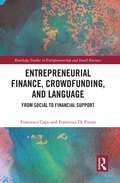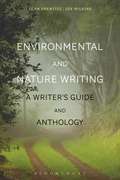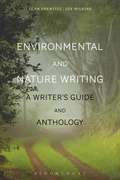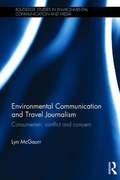- Table View
- List View
Entrepreneurial Finance, Crowdfunding, and Language: From Social to Financial Support (Routledge Studies in Entrepreneurship and Small Business)
by Francesca Capo Francesca Di PietroConsidering language a relevant strategic instrument that entrepreneurs and managers can use to seek external resources, this book investigates and discusses whether and under which conditions language strategies can facilitate entrepreneurs’ social support and legitimation as well as access to external resources.This book systematically integrates language into the entrepreneurial finance literature and develops a new and more comprehensive framework that relates crowdfunding to language strategies. Therefore, readers will comprehend how language choices, frames and narratives influence companies’ ability to secure social and financial support, and therefore sustain the development of their venture.Overall, this book provides insights into how entrepreneurs can use language as a strategic tool for accessing resources and support from external stakeholders, thereby considering, alongside traditional economic approaches, institutional processes of meaning-making.
The Entrepreneurial Journalist’s Toolkit: Manage Your Media
by Sara KellyToday’s journalism and communication students need the tools to develop and maintain their own media businesses and freelance careers. In addition to mastering the basics of converged journalism practice, they need training in business entrepreneurship, mass communication and business law, and career and reputation management. The Entrepreneurial Journalist's Toolkit provides a solid foundation of multimedia journalism and also teaches readers to create solid business plans and develop funding proposals while maintaining high legal and ethical standards. This book details the process of pitching and working with clients, managing multi-platform communication campaigns to maximize reach, keeping the books, and filing taxes. It is provides everything a new or experienced journalist needs to get started as a media entrepreneur.
The Entrepreneurial Journalist’s Toolkit: Manage Your Media
by Sara KellyToday’s journalism and communication students need the tools to develop and maintain their own media businesses and freelance careers. In addition to mastering the basics of converged journalism practice, they need training in business entrepreneurship, mass communication and business law, and career and reputation management. The Entrepreneurial Journalist's Toolkit provides a solid foundation of multimedia journalism and also teaches readers to create solid business plans and develop funding proposals while maintaining high legal and ethical standards. This book details the process of pitching and working with clients, managing multi-platform communication campaigns to maximize reach, keeping the books, and filing taxes. It is provides everything a new or experienced journalist needs to get started as a media entrepreneur.
Entrepreneurs Navigating a Universe of Disruption
by Gerard Anthony ReedThis book details the exploratory stages of a research study that produced a framework for entrepreneurial endeavour and enterprise. It presents an unfolding discussion, throughout its chapters, regarding the entrepreneurial nature potential within us all, and the modes by which those involved in such activity, and associated innovative discoveries, can be informed by the skills and experience already in their possession.The book also provides, through its structure, a tool by which the entrepreneur, innovator, educator, student or those yet-to-be involved in the entrepreneurial arena can plan for the yet-to-be known eventualities of such endeavour.The parabolic scramble framework is backgrounded across the discussion of entrepreneurship and the necessity to deal with the tangible and intangibility of any venture, as well as other considered aspects that the entrepreneurial journey engenders.
Entrepreneurship and Work in the Gig Economy: The Case of the Western Balkans (Routledge Focus on Business and Management)
by Mirjana Radović – Marković Borislav Đukanović Dušan Marković Arsen DragojevićThe crisis caused by COVID-19 poses a major challenge for the global economy and business. It has been a test for economic resilience, and how this crisis will affect business activities will be determined by their competitiveness. Only firms that have succeeded in reorienting and quickly adapting to the emerging crisis have continued without interruption in their operations, thus demonstrating their flexibility and high level of resilience. Research shows that companies driving the gig economy celebrate the benefits: flexibility, additional income, freedom and other various opportunities for workers. They require entrepreneurial digital skills that improve their competitiveness and benefit not only themselves but the economy as well. Therefore, digital competencies are becoming a significant resource and precondition for employment, and it is essential to promote digital entrepreneurial skills, introducing them into education programs through different forms of education. This book stresses and explores the importance of synergy between industry and virtual universities. Considering the importance of these issues, this book draws together literature on globalization and small and medium enterprise development and internationalization from disparate sources into a cohesive body of work, which traces the evolution of entrepreneurship and our understanding of the topic. It investigates the impact of digitalization on creating job opportunities in the labor market. Covering social, economic and psychological approaches to the most current topics, this book will be a useful framework to new theories and practices that are emerging to challenge conventional wisdom. It will be of interest to scholars, upper-level students, and researchers involved in the field of entrepreneurship.
Entrepreneurship and Work in the Gig Economy: The Case of the Western Balkans (Routledge Focus on Business and Management)
by Mirjana Radović – Marković Borislav Đukanović Dušan Marković Arsen DragojevićThe crisis caused by COVID-19 poses a major challenge for the global economy and business. It has been a test for economic resilience, and how this crisis will affect business activities will be determined by their competitiveness. Only firms that have succeeded in reorienting and quickly adapting to the emerging crisis have continued without interruption in their operations, thus demonstrating their flexibility and high level of resilience. Research shows that companies driving the gig economy celebrate the benefits: flexibility, additional income, freedom and other various opportunities for workers. They require entrepreneurial digital skills that improve their competitiveness and benefit not only themselves but the economy as well. Therefore, digital competencies are becoming a significant resource and precondition for employment, and it is essential to promote digital entrepreneurial skills, introducing them into education programs through different forms of education. This book stresses and explores the importance of synergy between industry and virtual universities. Considering the importance of these issues, this book draws together literature on globalization and small and medium enterprise development and internationalization from disparate sources into a cohesive body of work, which traces the evolution of entrepreneurship and our understanding of the topic. It investigates the impact of digitalization on creating job opportunities in the labor market. Covering social, economic and psychological approaches to the most current topics, this book will be a useful framework to new theories and practices that are emerging to challenge conventional wisdom. It will be of interest to scholars, upper-level students, and researchers involved in the field of entrepreneurship.
Entrepreneurship as Networking: Mechanisms, Dynamics, Practices, and Strategies
by Tom Elfring Kim Klyver Elco van BurgIn the world of business, who you know is usually more important than what you know. While most research highlights the personal characteristics and expertise important to business success, this book demonstrates that networking is the core of entrepreneurship. Both counterintuitive and powerful, this perspective reframes entrepreneurial action by placing networking at the center of the process. Traditionally, networks have been regarded as facilitators of business, but Tom Elfring, Kim Klyver, and Elco van Burg argue that networking is actually the basis of entrepreneurial action, and conversely, that entrepreneurial action is networking. In developing an "entrepreneurship as networking" model, the book addresses the persistent problems that plague the dominant "individual-opportunity" approach in entrepreneurship. They describe the key dynamics, mechanisms, and practices of entrepreneurship as networking, and point at fruitful networking strategies for entrepreneurs. Thus, the authors provide an integrated and dynamic account of entrepreneurial agency that prioritizes interaction with the surrounding social environment. They also explain what a viable network is for entrepreneurs and how networking activities affect their endeavours. Their perspective sheds new light on the origins of opportunities and how entrepreneurs access and mobilize resources. The approach also explains how entrepreneurs build legitimacy and exploit the networks they work within. Offering a groundbreaking theory of entrepreneurial action as networking, Entrepreneurship as Networking opens up an entirely new research agenda.
Entrepreneurship as Networking: Mechanisms, Dynamics, Practices, and Strategies
by Tom Elfring Kim Klyver Elco van BurgIn the world of business, who you know is usually more important than what you know. While most research highlights the personal characteristics and expertise important to business success, this book demonstrates that networking is the core of entrepreneurship. Both counterintuitive and powerful, this perspective reframes entrepreneurial action by placing networking at the center of the process. Traditionally, networks have been regarded as facilitators of business, but Tom Elfring, Kim Klyver, and Elco van Burg argue that networking is actually the basis of entrepreneurial action, and conversely, that entrepreneurial action is networking. In developing an "entrepreneurship as networking" model, the book addresses the persistent problems that plague the dominant "individual-opportunity" approach in entrepreneurship. They describe the key dynamics, mechanisms, and practices of entrepreneurship as networking, and point at fruitful networking strategies for entrepreneurs. Thus, the authors provide an integrated and dynamic account of entrepreneurial agency that prioritizes interaction with the surrounding social environment. They also explain what a viable network is for entrepreneurs and how networking activities affect their endeavours. Their perspective sheds new light on the origins of opportunities and how entrepreneurs access and mobilize resources. The approach also explains how entrepreneurs build legitimacy and exploit the networks they work within. Offering a groundbreaking theory of entrepreneurial action as networking, Entrepreneurship as Networking opens up an entirely new research agenda.
Entrepreneurship, Innovation And Business Clusters (PDF)
by Panos G. PiperopoulosIn Entrepreneurship, Innovation and Business Clusters, Panos Piperopoulos provides a comprehensive introduction to what entrepreneurship is all about, how and why entrepreneurs innovate and how innovation systems operate. Small and medium enterprises (SMEs) constitute the backbone of most economies, so the author examines their characteristics and the crucial role played by the owners and entrepreneurs who innovate to ensure the survival and continued growth of their firms. He also includes the particular phenomena that arise where the entrepreneurs are either female or from ethnic groups, or where the context is that of a developing region or country. The importance of co-operative strategic alliances and networks between firms is discussed, along with how these strengthen SMEs' competitiveness. The concept of open innovation has been proposed as a new paradigm for the management of innovation and the author presents a hypothetical model for enhancing the competitiveness and performance of SMEs by properly utilizing employees' creative potential, emotional intelligence, tacit knowledge and innovative ideas. The contemporary model of business clusters, involving partnerships with competitors, agents, universities, research centres and local, regional and national governments is discussed. The ways, means and methods through which SMEs' competitiveness and innovation can be enhanced within business clusters is illustrated by cases that identify four types of SMEs, that behave differently and play different roles in the networks and clusters of which they form a part, but all of whose performance and competitiveness is a function of their position and role in the wider scheme of things.
Entropy and Information Theory
by Robert M. GrayThis book is an updated version of the information theory classic, first published in 1990. About one-third of the book is devoted to Shannon source and channel coding theorems; the remainder addresses sources, channels, and codes and on information and distortion measures and their properties. New in this edition:Expanded treatment of stationary or sliding-block codes and their relations to traditional block codesExpanded discussion of results from ergodic theory relevant to information theoryExpanded treatment of B-processes -- processes formed by stationary coding memoryless sourcesNew material on trading off information and distortion, including the Marton inequalityNew material on the properties of optimal and asymptotically optimal source codesNew material on the relationships of source coding and rate-constrained simulation or modeling of random processesSignificant material not covered in other information theory texts includes stationary/sliding-block codes, a geometric view of information theory provided by process distance measures, and general Shannon coding theorems for asymptotic mean stationary sources, which may be neither ergodic nor stationary, and d-bar continuous channels.
Entropy Coders of the H.264/AVC Standard: Algorithms and VLSI Architectures (Signals and Communication Technology)
by Xiaohua Tian Thinh M. Le Yong LianThis book presents a collection of algorithms and VLSI architectures of entropy (or statistical) codecs of recent video compression standards, with focus on the H.264/AVC standard. For any visual data compression scheme, there exists a combination of two, or all of the following three stages: spatial, temporal, and statistical compression. General readers are first introduced with the various algorithms of the statistical coders. The VLSI implementations are also reviewed and discussed. Readers with limited hardware design background are also introduced with a design methodology starting from performance-complexity analyses to software/hardware co-simulation. A typical design of the Contextbased Adaptive Binary Arithmetic Coding (CABAC) encoder is also presented in details. To support System-on-Chip design environment, the CABAC design is wrapped with a SoC-based Wishbone system bus interface.
Entstehung der neuen politischen Akteure im globalen Kommunikationsraum (Globale Gesellschaft und internationale Beziehungen)
by Ibrahim AhmadovIbrahim Ahmadov stellt in der empirischen Studie über die Medienbotschaften des ehemaligen Al Qa’ida-Anführers Usama Bin Ladin fest, dass die Staatlichkeit an sich von den transnationalen Gewaltakteuren nicht negiert wird. Der Autor zeigt, dass das politische Handeln zwar der Staatlichkeit voran geht, das Staatswerden wird jedoch zum absoluten Ziel für die politischen Akteure im globalen System. Da dieses Ziel eine Dominanz im globalen Kommunikationsraum voraussetzt, zeichnet sich das gegenwärtige weltpolitische System durch die verlängerte Existenz von Übergangsakteuren aus.
Entwicklung der Telekommunikation in den neuen Bundesländern: Beispiel einer erfolgreichen Strukturanpassung (Schriftenreihe des Wissenschaftlichen Instituts für Kommunikationsdienste #16)
by Thomas Schnöring Uwe SzafranKommunikationsinfrastrukturen sind eine wichtige Voraussetzung für die wirtschaftliche und gesellschaftliche Entwicklung. Dieses Buch untersucht den Telekommunikationssektor in Ostdeutschland. Nach der Wende zeigte sich die ostdeutsche Telekommunikationsinfrastruktur zunächst als gravierendes Hemmnis für einen raschen wirtschaftlichen Aufschwung, in den Jahren danach wurden deutliche Fortschritte erreicht. Das Buch analysiert die Entwicklung des Sektors in der DDR vor der Wende, die Telekommunikationspolitik der Bundesregierung, die Entwicklung des Angebots der Telekom und ihrer privaten Wettbewerber sowie die Versorgung und die Zufriedenheit von Wirtschaft und Privathaushalten mit Telekommunikationsdiensten.
Entwicklung durch Interaktion: Bedeutungen und Praktiken im Feld Public Relations und Organisationskommunikation (Organisationskommunikation)
by Astrid SpatzierNeben einer historiografischen Analyse illustriert Astrid Spatzier in einer empirischen Berufsfeldstudie Rahmenbedingungen und deren Einfluss auf Verständnis- und Handlungsweisen von Praktikerinnen und Praktikern. Die Bezugnahme auf den Symbolischen Interaktionismus verspricht dabei eine Verschränkung von Mikro-, Meso- und Makro-Perspektiven, in dem die Handlungsebene in Abhängigkeit von organisationalen und gesellschaftlichen Bedingungen betrachtet wird. Zudem zeigt die Autorin Entwicklungsmöglichkeiten für Public Relations und Organisationskommunikation durch Interaktion auf. Die Studie liefert neben umfassenden empirischen Analysen zum Praxisfeld eine Grundlegung für Public Relations und Organisationskommunikation als Beruf.
Entwicklung und Evaluierung eines SDN-gestützten echtzeitfähigen Gerätenetzwerkes (BestMasters)
by Eike Björn SchweißguthEike Björn Schweißguth entwickelt und realisiert ein neues Echtzeitkommunikationssystem auf Basis des Software Defined Networking (SDN), welches Schwachstellen existierender Industrial-Ethernet-Systeme, wie schlechte Skalierbarkeit und spezielle Hardwareanforderungen, vermeidet und dennoch den hohen Anforderungen einer Automatisierungsumgebung gerecht wird. Der Autor ermöglicht somit auch für eine zukünftig steigende Zahl kommunizierender Geräte eine effiziente und kostengünstige Vernetzung.
Entwicklungslinien der Breitbandkommunikation: Vorgetragen in der Sitzung vom 9. Februar 1985 (Sitzungsberichte der Heidelberger Akademie der Wissenschaften #1985 / 5)
by Wolfgang KaiserEntwurf und Analyse von Kommunikationsnetzen: Netzplanung – Wartesysteme – Network Calculus
by Ulrich KillatDieses Lehrbuch ist eine einführende Darstellung verschiedener Verfahren des Entwurfs und der Analyse von Kommunikationsnetzen. Nachrichtentechniker und Informatiker mit dem Schwerpunkt „Kommunikationsnetze“ sollten damit vertraut sein. Es spannt einen Bogen von exakten Planungsverfahren (sowie entsprechenden Näherungsverfahren) über Leistungsbewertung mit Hilfe der Warteschlangentheorie bis hin zu Verfahren, die Schranken für Ende-zu-Ende Leistungsparameter in Netzen bestimmen. Das Buch legt Wert auf die Zusammenhänge zwischen den einzelnen Themen, die üblicherweise in getrennten Fachbüchern behandelt werden. Der Autor weckt ein intuitives Verständnis für die beschriebenen Verfahren, weswegen viele mathematische Voraussetzungen und Zusammenhänge in Anhängen behandelt werden. Beispiele aus eigenen Forschungsarbeiten dienen vielfach zur Verdeutlichung der vermittelten Sachverhalte.Hinweise zur Lösung aller Aufgaben finden sich auf der Plattform „DozentenPlus“ . Hier sind auch drei englischsprachige Power Point Präsentationen verfügbar, in denen der Stoff der drei Teile des Buches für Vorlesungen aufbereitet ist.
Entwurf und Analyse von Kommunikationsnetzen: Eine Einführung
by Ulrich KillatDieses Lehrbuch ist eine einführende Darstellung verschiedener Verfahren des Entwurfs und der Analyse von Kommunikationsnetzen. Nachrichtentechniker und Informatiker mit dem Schwerpunkt „Kommunikationsnetze“ sollten damit vertraut sein. Es spannt einen Bogen von exakten Planungsverfahren und entsprechenden Näherungsverfahren über Leistungsbewertung mit Hilfe der Warteschlangentheorie bis hin zu Verfahren, die Schranken für Ende-zu-Ende Leistungsparameter in Netzen bestimmen. Das Buch legt Wert auf die Zusammenhänge zwischen den einzelnen Themen, die üblicherweise in getrennten Fachbüchern behandelt werden. Der Autor weckt ein intuitives Verständnis für die beschriebenen Verfahren, weswegen viele mathematische Voraussetzungen und Zusammenhänge in Anhängen behandelt werden. Beispiele aus eigenen Forschungsarbeiten dienen vielfach zur Verdeutlichung der vermittelten Sachverhalte.
Environment Reporters in the 21st Century
by JoAnn Myer ValentiEnvironment Reporters in the 21st Century is the story of a relatively new journalistic beat, environmental reporting. This book explores the development of the environmental beat as a specialty during the last thirty years. It also discusses broader trends within American journalism resulting from technological changes that challenge traditional mediums, especially newspapers and magazines.The book is divided into three parts. The first reviews the literature and explains the methodology. The second describes the results of the authors' research. The third provides in-depth accounts of environment reporters at work. A final chapter puts the research in historical perspective, viewing it in terms of the economic decline of the newspaper business and of local television news.Journalists mediate a constant struggle among thousands of environmental activists, corporate public relations people, government officials, and scientists to shape environmental reporting. This volume tells the story of environmental reporting imaginatively and innovatively.
Environment Reporters in the 21st Century
by JoAnn Myer ValentiEnvironment Reporters in the 21st Century is the story of a relatively new journalistic beat, environmental reporting. This book explores the development of the environmental beat as a specialty during the last thirty years. It also discusses broader trends within American journalism resulting from technological changes that challenge traditional mediums, especially newspapers and magazines.The book is divided into three parts. The first reviews the literature and explains the methodology. The second describes the results of the authors' research. The third provides in-depth accounts of environment reporters at work. A final chapter puts the research in historical perspective, viewing it in terms of the economic decline of the newspaper business and of local television news.Journalists mediate a constant struggle among thousands of environmental activists, corporate public relations people, government officials, and scientists to shape environmental reporting. This volume tells the story of environmental reporting imaginatively and innovatively.
Environmental and Nature Writing: A Writer's Guide and Anthology (Bloomsbury Writers’ Guides and Anthologies)
by Sean Prentiss Joe WilkinsOffering guidance on writing poetry, nonfiction, and fiction, Environmental and Nature Writing is a complete introduction to the art and craft of writing about the environment in a wide range of genres. With discussion questions and writing prompts throughout, Environmental and Nature Writing: A Writers' Guide and Anthology covers such topics as: · The history of writing about the environment · Image, description and metaphor · Environmental journalism, poetry, and fiction · Researching, revising and publishing · Styles of nature writing, from discovery to memoir to polemic The book also includes an anthology, offering inspiring examples of nature writing in all of the genres covered by the book, including work by: John Daniel, Camille T. Dungy, David Gessner, Jennifer Lunden, Erik Reece, David Treuer, Bonnie Jo Campbell, Alyson Hagy, Bonnie Nadzam, Lydia Peelle, Benjamin Percy, Gabrielle Calvocoressi, Nikky Finney, Juan Felipe Herrera, Major Jackson, Aimee Nezhukumatathil, G.E. Patterson, Natasha Trethewey, and many more.
Environmental and Nature Writing: A Writer's Guide and Anthology (Bloomsbury Writers’ Guides and Anthologies #3)
by Sean Prentiss Joe WilkinsOffering guidance on writing poetry, nonfiction, and fiction, Environmental and Nature Writing is a complete introduction to the art and craft of writing about the environment in a wide range of genres. With discussion questions and writing prompts throughout, Environmental and Nature Writing: A Writers' Guide and Anthology covers such topics as: · The history of writing about the environment · Image, description and metaphor · Environmental journalism, poetry, and fiction · Researching, revising and publishing · Styles of nature writing, from discovery to memoir to polemic The book also includes an anthology, offering inspiring examples of nature writing in all of the genres covered by the book, including work by: John Daniel, Camille T. Dungy, David Gessner, Jennifer Lunden, Erik Reece, David Treuer, Bonnie Jo Campbell, Alyson Hagy, Bonnie Nadzam, Lydia Peelle, Benjamin Percy, Gabrielle Calvocoressi, Nikky Finney, Juan Felipe Herrera, Major Jackson, Aimee Nezhukumatathil, G.E. Patterson, Natasha Trethewey, and many more.
Environmental Communication and Travel Journalism: Consumerism, Conflict and Concern (PDF)
by Lyn McgaurrTravel journalism about natural attractions is environmental communication at the cusp of consumerism and concern. Countries and regions that market forests, rivers and wildlife to international tourists drive place-of-origin brand recognition that benefits exporters in other sectors. Place-branding in such destinations is not just PR for environmentally sustainable development and consumption, but also a political enterprise. Environmental Communication and Travel Journalismconsiders tourism public relations as elite reputation management, and applies models of political conflict and source-media relations to the analysis of the 'soft' genre of travel journalism. The book seeks to understand how, in whose interests and against what odds discourses of cosmopolitanism and place-branding influence the way travel journalists represent vulnerable and contested environments. Informed by interviews with journalists and their sources, Environmental Communication and Travel Journalism identifies and theorises networks, cultures, discursive strategies and multiple loyalties that can assist or interrupt flows of environmental concern in the cosmopolitan public sphere. The book should be of interest to scholars of environmental communication, environmental politics, journalism, tourism, marketing and public relations.
Environmental Communication Pedagogy and Practice (Routledge Studies in Environmental Communication and Media)
by Tema Milstein Mairi Pileggi Eric L. MorganGiven the urgency of environmental problems, how we communicate about our ecological relations is crucial. Environmental Communication Pedagogy and Practice is concerned with ways to help learners effectively navigate and consciously contribute to the communication shaping our environmental present and future. The book brings together international educators working from a variety of perspectives to engage both theory and application. Contributors address how pedagogy can stimulate ecological wakefulness, support diverse and praxis-based ways of learning, and nurture environmental change agents. Additionally, the volume responds to a practical need to increase teaching effectiveness of environmental communication across disciplines by offering a repertoire of useful learning activities and assignments. Altogether, it provides an impetus for reflection upon and enhancement of our own practice as environmental educators, practitioners, and students. Environmental Communication Pedagogy and Practice is an essential resource for those working in environmental communication, environmental and sustainability studies, environmental journalism, environmental planning and management, environmental sciences, media studies and cultural studies, as well as communication subfields such as rhetoric, conflict and mediation, and intercultural. The volume is also a valuable resource for environmental communication professionals working with communities and governmental and non-governmental environmental organisations.
Environmental Communication Pedagogy and Practice (Routledge Studies in Environmental Communication and Media)
by Eric Morgan Tema Milstein Mairi PileggiGiven the urgency of environmental problems, how we communicate about our ecological relations is crucial. Environmental Communication Pedagogy and Practice is concerned with ways to help learners effectively navigate and consciously contribute to the communication shaping our environmental present and future. The book brings together international educators working from a variety of perspectives to engage both theory and application. Contributors address how pedagogy can stimulate ecological wakefulness, support diverse and praxis-based ways of learning, and nurture environmental change agents. Additionally, the volume responds to a practical need to increase teaching effectiveness of environmental communication across disciplines by offering a repertoire of useful learning activities and assignments. Altogether, it provides an impetus for reflection upon and enhancement of our own practice as environmental educators, practitioners, and students. Environmental Communication Pedagogy and Practice is an essential resource for those working in environmental communication, environmental and sustainability studies, environmental journalism, environmental planning and management, environmental sciences, media studies and cultural studies, as well as communication subfields such as rhetoric, conflict and mediation, and intercultural. The volume is also a valuable resource for environmental communication professionals working with communities and governmental and non-governmental environmental organisations.



















